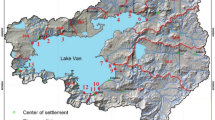Abstract
Estimating the lake level dynamics accurately on a daily or finer timescale is important for a better understanding of ecosystems, especially the lakes in Badain Jaran Desert, China. In this study, lake level dynamics of Sumu Barun Jaran are simulated and predicted on a 2-h timescale using the deep learning (DL) model, which is structured for the first time in this area by considering critical environmental factors. Two machine learning methods, namely multiple linear regression (MLR) and the three-layered back-propagation artificial neural network (ANN), are also adopted for the prediction purpose. The performances of these models are evaluated by comparing the values of average relative error, the mean squared error, and the coefficient of determination. The result shows that the DL model performs better than MLR and ANN on these three criteria, and this DL model is beneficial for exploring the mechanism of lake level dynamics in Badain Jaran Desert.






Similar content being viewed by others
References
Adamowski J, Chan HF (2011) A wavelet neural network conjunction model for groundwater level forecasting. J Hydrol 407(1):28–40
Bardossy A (2007) Calibration of hydrological model parameters for ungauged catchments. Hydrol Earth Syst Sci Discuss 11(2):703–710
Chen T, Wang X, Hu X, Lu H, Gong Y (2015) Clines in salt lakes in the Badain Jaran Desert and their significances in indicating fresh groundwater discharge. J Lake Sci 27(1):183–189
Costarelli D, Spigler R (2013) Multivariate neural network operators with sigmoidal activation functions. Neural Netw 48(6):72–77
Crapper PF, Fleming PM, Kalma JD (1996) Prediction of lake levels using water balance models. Environ Softw 11(4):251–258
Ditzler G, Polikar R, Rosen G (2015) Multi-layer and recursive neural networks for metagenomic classification. IEEE Trans Nanobiosci 14(6):608–616
Goh G, Hodas N, Vishnu A (2017) Deep learning for computational chemistry. J Comput Chem 38(16):1291
Gong Y, Wang X, Hu BX, Zhou Y, Hao C, Li W (2016) Groundwater contributions in water-salt balances of the lakes in the Badain Jaran Desert, China. J Arid Land 8(5):694–706
Havaei M, Davy A, Warde-Farley D, Biard A, Courville A, Bengio Y, Pal C, Jodoin PM, Larochelle H (2017) Brain tumor segmentation with deep neural networks. Med Image Anal 35:18–31
Khan MS, Coulibaly P (2006) Bayesian neural network for rainfall-runoff modeling. Water Resour Res 420(7):379–393
Kia MB, Pirasteh S, Pradhan B, Wan NAS, Moradi A (2012) An artificial neural network model for flood simulation using GIS: Johor River Basin, Malaysia. Environ Earth Sci 67(1):251–264
Knotters M, Bierkens MFP (2000) Physical basis of time series models for water table depths. Water Resour Res 36(1):181–188
Kumar DN, Maity R (2008) Bayesian dynamic modelling for nonstationary hydroclimatic time series forecasting along with uncertainty quantification. Hydrol Process 22(17):3488–3499
Li X, Cui B, Yang Q, Lan Y (2016) Impacts of water level fluctuations on detritus accumulation in Lake Baiyangdian, China. Ecohydrology 9(1):52–67
Li X, Pan R, Duan F (2017) Parameterizing stellar spectra using deep neural networks. Res Astron Astrophys 17(4):036
Maier HR, Dandy GC (1996) The use of artificial neural networks for the prediction of water quality parameters. Water Resour Res 32(4):1013–1022
Maiti S, Tiwari RK (2014) A comparative study of artificial neural networks, Bayesian neural networks and adaptive neuro-fuzzy inference system in groundwater level prediction. Environ Earth Sci 71(7):3147–3160
Mills K, Spanner M, Tamblyn I (2017) Deep learning and the Schrödinger equation. Phys Rev A 96(4):1–9
Park E, Parker J (2008) A simple model for water table fluctuations in response to precipitation. J Hydrol 356(3):344–349
Pollacco JAP, Ugalde JMS, Angulo-Jaramillo R, Braud I, Saugier B (2008) A linking test to reduce the number of hydraulic parameters necessary to simulate groundwater recharge in unsaturated soils. Adv Water Resour 31(2):355–369
Qian K, Liu X, Chen Y (2016) Effects of water level fluctuation on phytoplankton succession in Poyang Lake, China—a five year study. Ecohydrol Hydrobiol 16(3):175–184
Sartin MA, Silva ACRD (2013) Approximation of hyperbolic tangent activation function using hybrid methods. In: 2013 8th international workshop on reconfigurable and communication-centric systems-on-chip (ReCoSoC). IEEE, pp 1–6
Schmidhuber J (2015) Deep learning in neural networks: an overview. Neural Netw 61:85–117
Talebizadeh M, Moridnejad A (2011) Uncertainty analysis for the forecast of lake level fluctuations using ensembles of ANN and ANFIS models. Expert Syst Appl 38(4):4126–4135
Wang T (1990) Formation and evolution of Badain Jirin Sandy Desert, China. China J Desert Res 10(1):29–40
Wei CC (2015) Comparing lazy and eager learning models for water level forecasting in river-reservoir basins of inundation regions. Environ Model Softw 63:137–155
Xu T, Wang Y, Chen K (2016) Tailings saturation line prediction based on genetic algorithm and BP neural network. J Intell Fuzzy Syst 30(4):1947–1955
Yarar A, Onucyıldız M, Copty NK (2009) Modelling level change in lakes using neuro-fuzzy and artificial neural networks. J Hydrol 365(3):329–334
Yihdego Y, Webb JA, Leahy P (2015) Modelling of lake level under climate change conditions: Lake Purrumbete in southeastern Australia. Environ Earth Sci 73(7):3855–3872
Zhang J, Wang X, Jia F, Li G, Dong Y (2015) New insights into the flow directions of groundwater in Western Alxa, Inner Mongolia. Geoscience 35(3):774–782
Zhang J, Wang X, Hu X, Lu H, Ma Z (2017) Research on the recharge of the lakes in the Badain Jaran Desert: simulation study in the Sumu Jaran lakes area. J Lake Sci 29(2):467–479
Acknowledgements
This work was supported partially by the National Natural Science Foundation of China (nos. 61379126, 61662021, and 61772479), the Fundamental Research Funds for the Central Universities (2652017169) and by the Fundamental Research Funds for the Central Universities (China University of Geosciences (Beijing), China). The authors are grateful to the anonymous reviewers for their constructive comments.
Author information
Authors and Affiliations
Corresponding author
Additional information
Publisher's Note
Springer Nature remains neutral with regard to jurisdictional claims in published maps and institutional affiliations.
Rights and permissions
About this article
Cite this article
Wen, J., Han, PF., Zhou, Z. et al. Lake level dynamics exploration using deep learning, artificial neural network, and multiple linear regression techniques. Environ Earth Sci 78, 222 (2019). https://doi.org/10.1007/s12665-019-8210-7
Received:
Accepted:
Published:
DOI: https://doi.org/10.1007/s12665-019-8210-7




